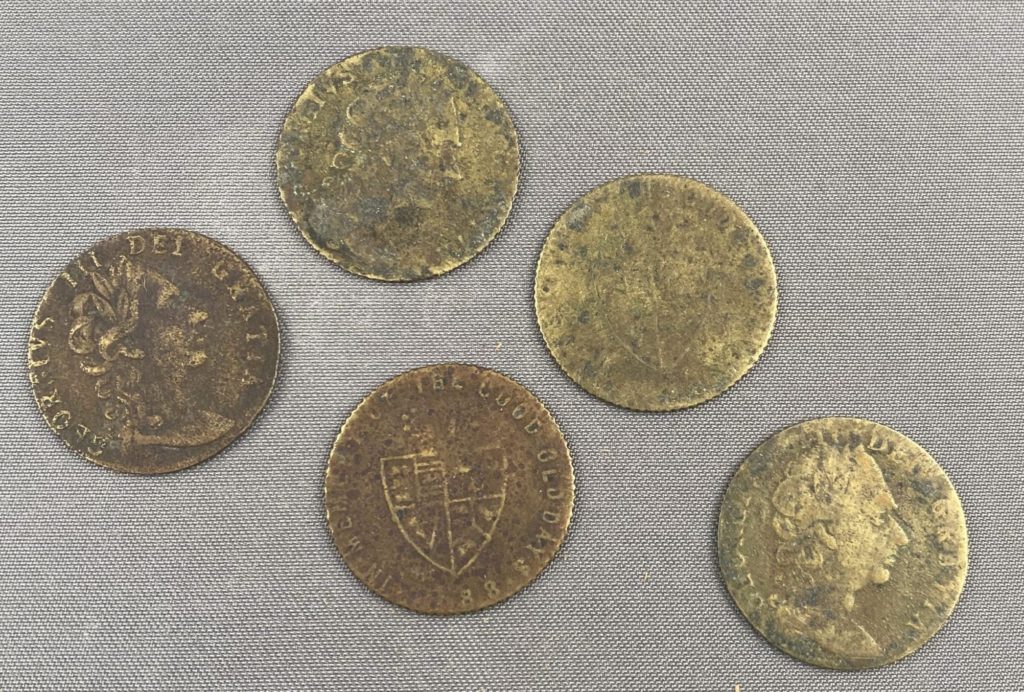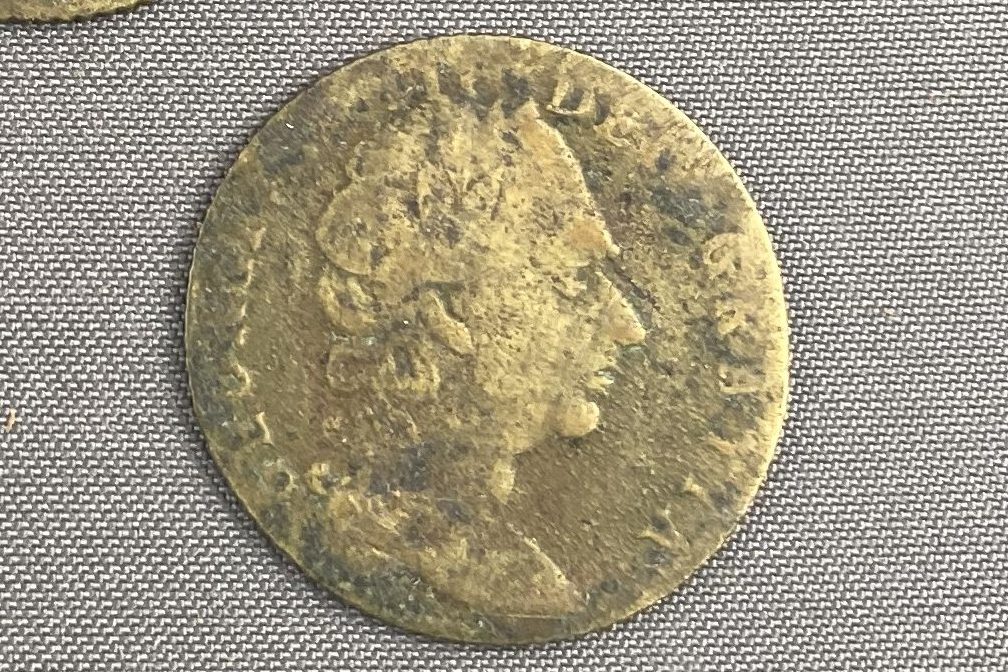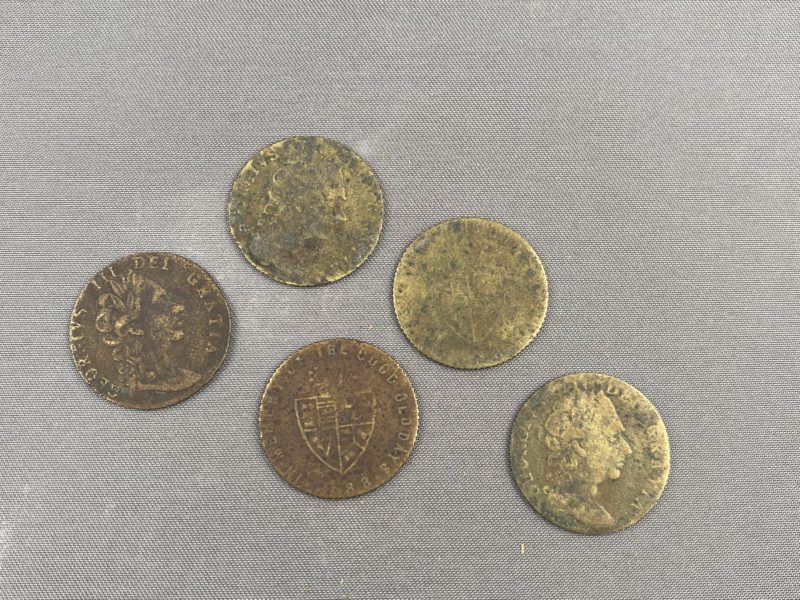An Investigation into Five Brass Imitation Spade Guineas
Article by Jack McLoughlin
Preamble:
First examining these objects not so much as an expert in numismatics as someone who had to Google what that word means, my first thought upon seeing some coins with an image of George III and the date stamped 1788 was that these must be quite valuable. In fact, these coins are neither rare nor valuable, have never been legal tender and in fact were not even from 1788. This was my introduction to the world of imitation guineas.

So what is an Imitation Spade Guinea?
During Victorian times, imitation coins were produced on a surprisingly large scale. While some were produced as souvenir trinkets to be passed out at events, some as props to be used in plays and others were used as advertisements demonstrating the skill of the metalworking businesses producing them, the widespread practical use of these coins was as gambling tokens. [1]
Of course an obvious alternative use of imitation coinage is to attempt to pass them off as currency. However, these imitation guineas were manufactured in such a way that no one at any time would have suspected that the manufacturer had the same intention as that of the notorious William Chaloner, who had a “coyning” operation ran out of Egham at the end of the 17th century. [2]
These imitation guineas would in fact have appeared humorous to a Victorian of the time. For one thing, a guinea was a valuable coin made out of a precious metal [3] and the idea of a brass guinea may have seemed about as serious an idea to a Victorian as the idea of chocolate money does to us today.
And just in case the Victorian handling these tokens, or jetons (from the French jeter meaning to throw) somehow missed their comic nature looking at a faithful reproduction of George III’s face, name and the message DEI GRATIA (by the Grace of God) on one side, flipping the coin over would reveal a message that obviously would not have come from the Royal Mint. These messages could be simply the manufacturer’s name, or as in the case of the ones at Egham museum photographed above, “IN MEMORY OF THE GOOD OLD DAYS 1788”. In our current age of rapid and often unsettling change, it’s thought provoking that people back in what we might very much consider to be the good old days ourselves were themselves pining for a simpler time!
Continuing with the theme of the sensibility of British people perhaps not changing all that much over the years, some of these jetons still in existence have a decidedly satirical bent to them including messages such as TO HANOVER, a possible reference to Queen Victoria’s uncle having inherited the Kingdom of Hanover to which no female heir could succeed [4]. One online source even speculated that our own coin’s message about the good old days is a sarcastic tribute to the hundredth anniversary of the Glorious Revolution of 1688, William of Orange’s ascension to the throne, although it’s hard to believe it would have been perceived as more than a simple nostalgic message by most people.
Whatever the intentions of the manufacturer, no Victorian in their right mind would have ever mistaken any of these imitation coins for real currency and therefore the manufacturers felt they had nothing to fear from counterfeiting laws. However, the practice evidently ruffled some official feathers and it began to be targeted by legislation in the 1860s, being further restricted by the 1883 Counterfeiting Act, with the manufacture at scale of these imitation coins ending around the time of the First World War. [5]

Where did the Museum’s come from?
The museum’s coins bear no signature and museum records indicate that they were found by Henry and Frederick Attwater during the demolition of Rose Cottage in Egham in the late 1950s and early 1960s.
It turns out that a lot of the manufacturing of these coins was done in the Midlands, and Birmingham in particular [6], which has a long tradition of metal working shops and similar light industry.
We can further narrow down the search by looking at similar imitation guineas. The coins we have are “spade” guineas, so named because the shield on the reverse side of the King’s face resembles the blade of the digging tool.
Searching for a manufacturer, it seems that someone who is at least connected to the manufacture of our imitation spade guineas is one Charles Peverelle who is believed to have set up his shop in 1866 in Birmingham [7]. This connection is suggested because another type of imitation guinea that exists is identical to our museum’s coins in every way except for the replacing of the “In Memory of…” slogan with “CHARLES PEVERELLE MAKER BIRM 1788”. [8]
While it could be that the same casting die was used to make our guineas, with Peverelle’s shop editing the text at some point going from his signature to “in memory of…” or vice versa, given the large number of such coins in existence, we cannot discount the possibility that the casting dies for making these coins were duplicated or passed or sold on among the people involved in the industry and therefore we are unable to attribute the product to him with certainty.
Conclusion
While these Victorian poker chips in our museum are themselves not valuable and can be bought by the box on eBay inexpensively, these artifacts touch on several interesting points in the history of the land, from manufacturing and historical counterfeiting to recreational culture and royalty.
Bibliography
[1] https://www.thetokensociety.org.uk/article.pdf
[2] Newton and the Counterfeiter, by Thomas Levenson, Mariner Books, 2010
[3] https://www.chards.co.uk/1788-gold-spade-guinea-george-iii-fifth-laureate-portrait/11093
[4] https://www.whitmorectm.com/immitation-guineas
[5] http://www.britnumsoc.org/publications/Digital%20BNJ/pdfs/2016_BNJ_86_13.pdf
[6] https://www.britnumsoc.org/publications/Digital%20BNJ/pdfs/1963_BNJ_32_15.pdf
[7] https://www.britnumsoc.org/publications/Digital%20BNJ/pdfs/1963_BNJ_32_15.pdf


